Chapter 12
Conducting a Virtual Orchestra
In This Chapter
![]() Creating an orchestral template
Creating an orchestral template
![]() Loading and playing orchestral patches
Loading and playing orchestral patches
![]() Defining a productive composing workflow with screensets
Defining a productive composing workflow with screensets
![]() Playing samples with expression and articulation
Playing samples with expression and articulation
Imagine standing in front of a full fifty-piece orchestra, conducting your own score. The music builds, section by section, into a glorious peak. You pull the intensity down gracefully and a lone trumpet plays a short, plaintive motif over a bed of lush strings. A tear falls in the audience. And then silence, before a slow roar of applause overtakes the concert hall. Flowers are thrown and the crowd begins chanting, “Encore!”
You may have to imagine the applause and chanting. But Logic Pro will provide the orchestra.
Orchestral instruments will never go out of style. An orchestra is Hollywood’s best friend. Plus, Logic Pro shines at film scoring. You learn how to import video in Chapter 8. In this chapter, you discover how to set up an orchestra and score your own soundtrack.
A video isn’t required to compose with an orchestra. But if you’d like to practice scoring to video, an online search for royalty-free video will give you something to import into your project.
One giant reason why Logic Pro is great at orchestration is its music notation capabilities. The notation displayed in the score editor is separate from the MIDI events, so the score can look perfect even if the playing isn’t. You can view the score layout in Logic Pro and print lead sheets for the performers and the complete orchestral score for the conductor. If you read music, you'll find that the score editor is a great place to input music, especially if you’re transcribing a score from sheet music. The Project Gutenberg online library has scores that you can input for practice or fun.
Building an Orchestral Template
Logic Pro X comes with an enormous selection of sampled orchestral instruments. These sophisticated samples are available as patches in the library. Most of the patches include the Space Designer plug-in, which recreates acoustic environments, so you have exceptional control over the sound of your orchestra.
Note: You may already have an orchestral template installed with Logic Pro X. For many users, the orchestral template isn’t included in the installation, even when they download the additional content (as you discover later in this section). I want to teach you how to create an orchestral template so that you can create your own personalized template and be encouraged to experiment with the orchestra. This template, along with a video guide, is available at http://logicstudiotraining.com/lpxfordummies.
Setting up an orchestral template will save you time when inspiration strikes. Create the template once and then use it over and over again. To begin, create a new empty project:
- Choose File⇒New from Template (
 -N).
-N).
The template chooser window opens, as shown in Figure 12-1.
- In the template chooser, select the Empty Project template.
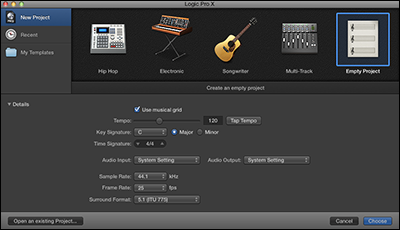
Figure 12-1: The template chooser.
- In the Details area, select the project settings you want.
If the Details area is closed, click the disclosure triangle to reveal the project settings.
- Click the Choose button.
The new tracks dialog appears.
- Select the Software Instrument option and enter the number of tracks you want to create.
For this example, enter 32 in the number of tracks field. You’ll be able to fit a full orchestra on 32 tracks with a few tracks to spare.
- Click the Create button.
The main window of your new project opens.
Choosing your orchestral instruments
Orchestras come in lots of shapes and sizes. The Logic Pro orchestral patches can deliver the most common variations. And of course you’re not limited to using acoustic samples exclusively. You can mix an orchestra with electronic instruments or a rock band, for example.
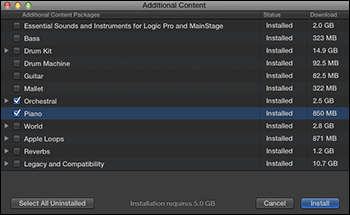
Figure 12-2: The Additional Content window.
Before you load your tracks with patches, decide on the orchestra you want. Following is a list of common orchestrations with their patch names:
- Full orchestra: A full orchestra consists of woodwinds, brass, percussion, harp, piano, and strings. You can load the following patch names: Piccolo, Flutes, Oboe, English Horn, Clarinets, Bassoon Solo, French Horns, Trumpets, Trombones, Tuba, Timpani, Orchestral Kit, Glockenspiel, Harp, Grand Piano, Violins 1, Violins 2, Violas, Cellos, and Basses.
- String orchestra: A string orchestra consists of strings, harp, piano, and percussion. You can load the following patch names: Violins 1, Violins 2, Violas, Cellos, Basses, Harp, Grand Piano, Timpani, and Orchestral Kit.
- Concert band: A concert band consists of woodwinds, brass, harp, piano, and percussion. You can load the following patch names: Piccolo, Flutes, Oboe, English Horn, Clarinets, Bassoon Solo, Saxophone, French Horns, Trumpets, Trombones, Tuba, Glockenspiel, Harp, Grand Piano, Timpani, and Orchestral Kit.
Choosing appropriate staff styles
Staff styles are used to store information about how a region should be displayed in the score editor. Orchestral instruments are traditionally associated with a specific clef type and transposition, for example. Choosing a staff style allows you to quickly adjust how a region or entire track will look.
The orchestral patches in your library already have the appropriate staff style saved with the patch. However, you can easily change the staff style of a track by following these steps:
- Select the track.
- Open the inspector by choosing View⇒Show Inspector (I).
The inspector opens on the left side of the main window.
- Open the track inspector pane, shown in Figure 12-3, by clicking the disclosure triangle.
- In the Staff Style drop-down list, select the style.
The track will use the new staff style in the score editor.
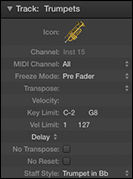
Figure 12-3: The track inspector.
A great example of when you might want to change the staff style is with the Trumpets patch. The staff style that loads with the Trumpets patch is transposed for Bb trumpet, which means the trumpet notation is transposed up two semitones. If you compose and orchestrate in the score editor, you might want to switch between the instrument’s staff style to a style with no transposition. You can compose more quickly when you don’t have to continually do the mental transposition in the score editor. To edit the staff style, simply follow these steps:
- Select the track.
- Choose View⇒Show Editor (E).
The editor window opens at the bottom of the tracks area.
- Click the Score tab to display the score editor.
- On the score editor menu, choose Layout⇒Show Staff Styles.
The staff styles window opens, as shown in Figure 12-4.
- In the Transpose field, drag your cursor up or down to change the value.
The score editor instantly updates to the new transposition for all tracks that use the same staff style.
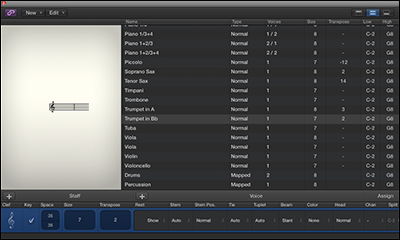
Figure 12-4: The staff styles window.
Saving your orchestral template
With all your patches loaded, you could save your project as a template by choosing File⇒Save as Template. But there’s more you can do to make this template a composer’s playground. Because your work as a composer is made up of many different tasks, you can create screensets dedicated to specific workflows. Here are some screenset ideas to help you compose faster:
- Choose instruments and input parts. In the beginning of a project, you spend a lot of time auditioning different instrument patches. Open the library (Y) to make patch selections fast. The tracks area will already be open, enabling you to record new regions and select tracks. If you also open the editor (E), you’ll be able to quickly input notes into the piano roll, score, or step editor.
- Perform parts with smart controls. When you record, you need to capture your best performance. Open the smart controls (B) to have immediate control over the different articulations of these orchestral patches.
- Set the project key and tempo. If you’re composing to video, you need regular access to the global tracks to time your music to the video. Open the score editor in a new window (
 -5) and display the global tracks (G). This view gives you a score for referencing your music and the global tracks for inputting tempo and key changes (for details, see Chapter 4).
-5) and display the global tracks (G). This view gives you a score for referencing your music and the global tracks for inputting tempo and key changes (for details, see Chapter 4). - View the score editor in linear view. See the entire score scroll in front of you. Open the score editor in a new window (
 -5), and choose View⇒View Mode⇒Linear View on the score editor menu. Input notes in the score editor by using the pencil tool.
-5), and choose View⇒View Mode⇒Linear View on the score editor menu. Input notes in the score editor by using the pencil tool. - Edit MIDI. Adjusting note lengths and velocities is fast and easy in the piano roll editor. A giant piano roll editor in the tracks area makes MIDI editing simple. (To find out how to edit MIDI, see Chapter 15.)
- Engrave music. Similar to linear view, the score editor looks beautiful in page view, as shown in Figure 12-5. Open the score editor in a new window and select View⇒View Mode⇒Page View. From this view, you can add ornaments and text from the part box in the inspector (I) and print your score for the musicians and conductor.
- Produce the final mix. You adjust the levels of the individual instruments in the mixer. Open the mixer in a new window (
 -2) and make it as big as you can. You learn all about the mixer in Chapter 16.
-2) and make it as big as you can. You learn all about the mixer in Chapter 16. - View video. If you have a video imported into your project, choose View⇒Show Movie Window. Watch the movie and play what you see. Sound simple? Logic Pro does its best to make it so.
- Use project notes. If you work with a team, documenting your work is a must. Open the project notes by choosing View⇒Show Note Pads (Option-
 -P). In the project notes, create a log of important changes, instructions, lyrics, or anything else you want to remember later.
-P). In the project notes, create a log of important changes, instructions, lyrics, or anything else you want to remember later.

Figure 12-5: Score editor page view.
When you have these screensets set up the way you like, choose Lock on the screenset menu. After the screensets are locked, you can make changes to the view as much as you like but your original settings will be recalled when you choose the screenset.
Performing Your Orchestra
Your orchestral patches come with several velocity levels and different articulations to help you create realistic sounding performances. The patches also load with smart controls designed to make your performances expressive and dynamic.
Select a track and open the smart controls (B), as shown in Figure 12-6. Note the Legato and Staccato buttons in the clarinet smart controls; these switch between two articulation samples. You can quickly assign these buttons to your MIDI controller; for details, see Chapter 3.

Figure 12-6: The woodwind smart controls.
Sampler instruments are often a surprise to play. You never know how many different samples or velocity levels you can experiment with. Designers of great sample instruments give you instruments that are instantly playable, and the Logic Pro X patches deliver on that promise with their intuitive design. But if you want to know exactly what your instrument can do, there’s no better place than the EXS24 sample instrument editor. A good patch on which to perform a sample autopsy is the Orchestral Kit:
- Select the track that has the Orchestral Kit patch loaded.
You should already have a track with the Orchestral Kit patch loaded if you followed the instructions in the “Choosing Your Orchestral Instruments” section.
- Open the EXS24 by clicking the center of the instrument slot in the inspector (I).
- Click the Edit button in the upper right of the EXS24 interface.
The Instrument Editor window opens.
- On the instrument editor menu bar, click the Show Velocity button.
The velocity area shows above the keyboard and zones/group area.
Note how some of the keys have multiple levels of velocity, as shown in Figure 12-7. Depending on how hard you hit your MIDI controller, different samples will play. Each sample turns blue as you play it. Watching the velocity of a multisampled EXS24 instrument as you play is a great way to get to know the feel of your MIDI controller. Working with the instrument's preset velocity will help you to play a sampled instrument more expressively.
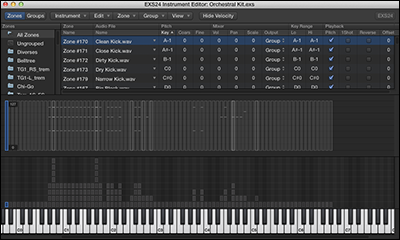
Figure 12-7: The EXS24 Instrument Editor window.
Visit http://logicstudiotraining.com/lpx4dummies to download a template that has the natural ranges of the orchestral instruments written in the track notes.
Traveling the World Instruments
As a composer, the ability to use instruments from other cultures provides the opportunity to create authentic scores and satisfy artistic and client needs. In addition to the full orchestra you already have, you can create a project alternative that includes groups of world instrument patches. To create a new project alternative, do the following:
- Choose File⇒Alternatives⇒New Alternative.
The new alternative dialog opens.
- Enter your new alternative name and click OK.
A new project alternative is created, duplicating the current project settings.
Here are several groups of patches you could add to the full orchestra:
- India: Indian Bansuri Flute, Indian Shehnai Oboe, Indian Sitar, Indian & Middle Eastern Kit
- Africa: African Kalimba, African Kit, South African Singers, South African Voice Effects
- Medieval: European Folk Kit, Celtic Hammered Dulcimer, Celtic Harp, Medieval Lute, Celtic Tin Whistle, Medieval Recorder, Irish Bouzouki
- Asia: Asian Kit, Indonesian Gamelan, Tibetan Singing Bowls, Chinese Erhu Violin, Chinese Guzheng Zither, Chinese Ruan Moon Guitar, Japanese Koto, Chinese Dizi Flute, Chinese Xiao Flute, Japanese Shakuhachi Flute
With these patches and your new orchestral template, you can follow in the footsteps of John Williams and pull the heartstrings of movie watchers. You can learn from the masters and input scores of composing giants Bach, Mozart, and Beethoven. You can add a string orchestra to your next rock song or record an Indian raga. There’s so much you can do, and now that you have your orchestra saved as a template and a patch, you can add it to any project that needs a virtual orchestra.

 You must download additional content to take advantage of orchestral patches. Choose Logic Pro X⇒Download Additional Content. Select the Orchestral and Piano check boxes in the Additional Content window, as shown in Figure
You must download additional content to take advantage of orchestral patches. Choose Logic Pro X⇒Download Additional Content. Select the Orchestral and Piano check boxes in the Additional Content window, as shown in Figure  Logic Pro X comes with several different grand piano patches, so you can choose between a Yamaha, a Boesendorfer, or a Steinway grand piano. Many orchestral patches also have solo patches in addition to the ensemble patches, such as the French Horn, Clarinet, and Flute. And if you don’t want to work with individual instruments and would rather compose with full sections, you can use the Full Brass and Full Strings patch as well as several genre-specific patches such as Romance Strings, Cinema Strings, and Pop Strings.
Logic Pro X comes with several different grand piano patches, so you can choose between a Yamaha, a Boesendorfer, or a Steinway grand piano. Many orchestral patches also have solo patches in addition to the ensemble patches, such as the French Horn, Clarinet, and Flute. And if you don’t want to work with individual instruments and would rather compose with full sections, you can use the Full Brass and Full Strings patch as well as several genre-specific patches such as Romance Strings, Cinema Strings, and Pop Strings.